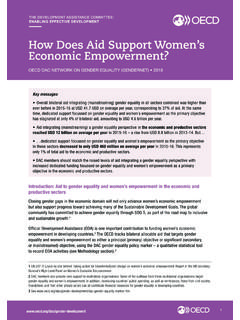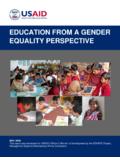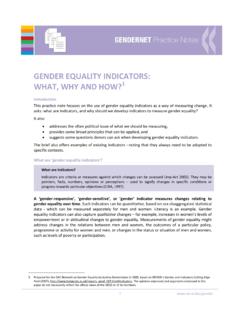Transcription of The role of men and boys in promoting gender equality
1 1 The role of men and boys in promoting gender equality Presentation at the Harvard Club, New York 7 May 2007. I welcome the opportunity to discuss with you this evening this most important topic. I would like to begin by briefly outlining the evolution of the attention to men and boys in the gender equality work and then outline some of the challenges we face in moving forward. I. INTRODUCTION. Early efforts for the advancement of women: The goal of promoting gender equality (or equality between women and men) has been on the agenda of the international community since the founding of the United Nations. It is well established in the UN leaders assembled at the 2005 World Summit at the UN here in New York affirmed that Progress for women is progress for all . The initial work of the United Nations in this area was labelled advancement of women.
2 Efforts focused on compiling data and statistics and analyzing the situation of women around the world. Work on the empowerment of women and on securing the human rights of women, for example political rights, was given importance at an early stage. Women in development: By the mid 1960s - particularly with the increased number of developing countries in the United Nations - attention was given to what became known as women in development . The initial focus was on ensuring that women were involved in development efforts and that the benefits of development reached women as well as men. As this work progressed, it became increasingly clear, however, that women were already participating in development efforts in fact they were the mainstay of development in many parts of the world, particularly in rural areas. Awareness grew that sustainable development could not be achieved unless the contributions of women were recognized and build upon and unless all development efforts took into account the priorities and needs of women as well as men and the potential impacts of actions on them.
3 Frameworks and mechanisms in place: Over the past six decades, strong global policy and legal frameworks on gender equality have been put in place - The Platform for Action adopted in consensus in Beijing in 1995 and the human rights treaty, the Convention on the Elimination of All Forms of Discrimination against Women (CEDAW) adopted in 1979 and now endorsed by 185 states. Specific mechanisms have been established at international, regional and national levels to support the implementation of these critical frameworks. Since much of the earlier efforts for gender equality had taken place through separate activities for women, apart from and on the margins of the mainstream development efforts, a strategy gender mainstreaming - was established to bring women's perspectives to the centre of attention (the mainstream) by working to ensure that all policies, programmes and 2 activities take the contributions, priorities and needs of both women and men into consideration.
4 This strategy is considered essential to ensure achievement of gender equality but also critical for achieving sustainable development goals in all areas, such as those related to poverty, education, health, agriculture and environment. Gaps in implementation: Despite all these efforts at global level, and subsequent actions at regional and national levels, there remains today a significant and serious gap in implementation at national level. Change has happened and achievements have been made but the pace of change has been too slow. There are many reasons for this discrepancy between policies and commitments/obligations at global level and action on the ground including insufficient awareness and capacity, political will and resource allocations. One other important reason for the slow progress in achieving equality between women and men is the failure to adequately raise awareness of and involve men at all levels.
5 gender equality cannot be achieved by women alone or by focusing exclusively on women. gender equality concerns both women and men and change in this area requires the involvement of men as well as women. II. MOVING TO ENGAGE MEN AS WELL AS WOMEN. Shift to relations between women and men: While the initial focus on the advancement of women was exclusively on women as a separate group, a category unto themselves, it became evident that information and data on women without comparison with the situation of men are not useful. Statistics whether on, for example, access to credit, inheritance and land rights, access to different levels of education, or involvement in decision-making in different areas - need to be sex-disaggregated so that it is possible to identify and address constraints and challenges to the achievement of equality between women and men.
6 By the mid 1970s, experts were pointing to the fact that it if not possible to work with women's advancement in a vacuum. Much of the inequality and discrimination women faced was directly linked to their relations with men particularly in terms of access to resources and decision-making. A clear distinction was made between biological differences between women and men (sex) and differences and inequalities that are socially constructed and which can differ over time and in different contexts ( gender ). This opened up the way for greater attention to men as well as women and to the relations between them. Examples of the need to involve men from development cooperation: Many examples from work in development cooperation in the 1980s and 1990s illustrated the need to increase the focus on men as well as women. The achievement of reproductive health goals an area involving intimate relations between women and men - is one clear example.
7 While women in many countries could be trained on their reproductive health needs and provided access to clinics and contraceptives, full utilization of the information and services by women was only possible if men were also made aware of the 3 need for change and engaged in the process. This was particularly so in societies where men control family decision-making, including on family size and access to contraceptives. Many well-intentioned empowerment efforts such as giving women access to income-generating activities and cash - led to backlash, including increased violence against women, since men were not brought along in the change process and felt that their role as family provider and head of household was being undermined and that they were losing their control over their wives. This was particularly problematic in areas where men themselves had difficulties accessing employment or other income-generating activities since issues of male status and prestige came into play.
8 Other development efforts under the gender mainstreaming strategy which attempted to increase the participation of women also ran into difficulties when men were ignored in the process. For example, in a water project in Africa, efforts of an aid agency to involve women more effectively as pump attendants met stiff resistance from men, particularly when it was proposed that women pump attendants should also be given bicycles to allow them to carry out their work. Men objected first on the grounds the women could not learn to ride bicycles. When that was proven wrong, the real objections emerged, that is, that bicycles a clear status symbol in a poor community should not be given to women if men did not already have them. The aid agency learnt the important lesson that efforts for gender equality and the empowerment of women must include awareness raising and engagement of men.
9 Care was needed in efforts to increase women's involvement, through the gender mainstreaming strategy, not to simply increase the work burden of women without giving them increased access to decision-making and lead to the disengagement of men. As some experts warn in relation to efforts to increase food production in rural areas in Africa, the focus should not be on increasing the inputs of women who are already making significant contributions but increasing the responsibility and inputs of men in food crop production. Women's lack of resources, power, time and the constraint of violence: Addressing many of the constraints and challenges women face require a focus on men and the relations between women and men. Women have unequal access to resources compared with men which constrains their involvement in and access to the benefits of development.
10 An illustrative example is the fact that women in all parts of the world continue to earn less for work of equal worth. In many parts of the world, women have few rights to land, property and inheritance and less access to credit and other financial resources. Change in these areas directly affects men and will require their involvement in the change process. Around the world, men dominate in decision-making positions in all areas. Women in 2007 still constitute only around 16% of Parliamentarians, and similar or worse situations exist in relation to women's representation in decision-making in key areas, such as in the executive, economic decision-making, media, academia and the judiciary. In many of these areas reliable and comparable global statistics still do not exist. For an illustration of this close to home, take a look, for example, at the photograph of the 10 Republican candidates for the presidency in the New York Times last week not a woman to be seen.
















